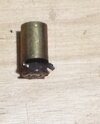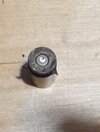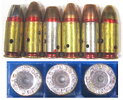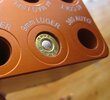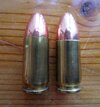Riomouse911
Member
…had this WWB 124 gr 9mm cartridge allowed the slide to go forward a tiny bit more! 
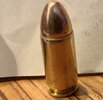
I took a few autos to the range today, Kimber Micro 9, CZ 75 SP-01 & Glock 48 9mm’s and a Ruger SR1911 4.25” and CZ 97-B .45’s.
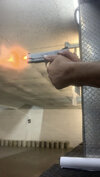
The star of the day was the 97-B. The gun just shot where I pointed it while the others were not as consistent for me. I even played “shoot 10 at 10” through the SP-01, 48 and 97B one right after the other, and kept them where it counts.
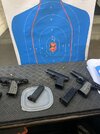
The issue popped up when I was shooting the SP-01 near the end of the session. About halfway through the mag I fired a shot and the guns trigger did not reset as it should. Not feeling right, I stopped and saw that the slide was out of battery, still hanging over the end of the frame by a little bit.
I dropped the mag, and the slide would not retract at all. I pulled on it a bit with no luck, then I kept it pointed down range and tapped it lightly against the range table. This broke it free, and I extracted the round.
I picked up the cartridge that fell out and immediately saw that the case mouth was “roll crimped”, which (of course) wasn’t right. I eyeball-measured it against another unfired round and saw that the offending case was too long. Clearly it jammed hard into the chamber and the case mouth was crimped inward by the barrel as it was forced past the end of the chamber.
I took that case home and it measured an unscientific .786 with my caliper. Other unfired Winchester rounds measured .746, .748 and .748, and Fiocchi rounds measured .748 and .749. (SAAMI is .754 +/- .010. The case in question is on the right.)
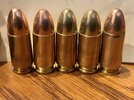
I am glad it didn’t fire, I can just imagine the excess pressure that would have been generated as the cartridge mouth was unable to expand enough to properly release the bullet.
Sometimes even when things go wrong there is a lesson to be gleaned from the event.
As always, if things don’t look, sound or feel right, STOP! If you are shooting on a range line or competitive event let others/range staff know there is an issue. Once folks are aware, unload, make the gun safe and check for what may be amiss.
Stay safe.

I took a few autos to the range today, Kimber Micro 9, CZ 75 SP-01 & Glock 48 9mm’s and a Ruger SR1911 4.25” and CZ 97-B .45’s.

The star of the day was the 97-B. The gun just shot where I pointed it while the others were not as consistent for me. I even played “shoot 10 at 10” through the SP-01, 48 and 97B one right after the other, and kept them where it counts.


The issue popped up when I was shooting the SP-01 near the end of the session. About halfway through the mag I fired a shot and the guns trigger did not reset as it should. Not feeling right, I stopped and saw that the slide was out of battery, still hanging over the end of the frame by a little bit.
I dropped the mag, and the slide would not retract at all. I pulled on it a bit with no luck, then I kept it pointed down range and tapped it lightly against the range table. This broke it free, and I extracted the round.
I picked up the cartridge that fell out and immediately saw that the case mouth was “roll crimped”, which (of course) wasn’t right. I eyeball-measured it against another unfired round and saw that the offending case was too long. Clearly it jammed hard into the chamber and the case mouth was crimped inward by the barrel as it was forced past the end of the chamber.
I took that case home and it measured an unscientific .786 with my caliper. Other unfired Winchester rounds measured .746, .748 and .748, and Fiocchi rounds measured .748 and .749. (SAAMI is .754 +/- .010. The case in question is on the right.)

I am glad it didn’t fire, I can just imagine the excess pressure that would have been generated as the cartridge mouth was unable to expand enough to properly release the bullet.
Sometimes even when things go wrong there is a lesson to be gleaned from the event.
As always, if things don’t look, sound or feel right, STOP! If you are shooting on a range line or competitive event let others/range staff know there is an issue. Once folks are aware, unload, make the gun safe and check for what may be amiss.
Stay safe.


